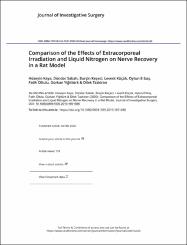Comparison of the Effects of Extracorporeal Irradiation and Liquid Nitrogen on Nerve Recovery in a Rat Model

Göster/
Tarih
2019Yazar
Kaya, HüseyinSabah, Dündar
Keçeci, Burçin
Küçük, Levent
Erbaş, Oytun
Oltulu, Fatih
Taşkıran, Dilek
Üst veri
Tüm öğe kaydını gösterÖzet
Aim of the study: Biologic reconstruction using tumor-bearing bone autografts devitalized by liquid nitrogen or extracorporeal irradiation (oncological sterilization) is a safe and effective method in musculoskeletal surgery. The purpose of this study was to examine the effects of these two oncological sterilization methods on nerve recovery. Methods: A total of 48 rats were randomly divided into 3 groups as autograft, irradiation and liquid nitrogen groups. A nerve defect created in the right sciatic nerve was reconstructed with an autograft obtained from the nerve itself. Group I underwent reconstruction with standard nerve autograft. Group II and Group III underwent reconstruction with devitalized nerve autograft treated through extracorporeal irradiation and liquid nitrogen, respectively. The left sciatic nerves of the rats served as control. Electromyography, motor function test and histomorphological analysis were performed to assess the nerve recovery on the 3rd (early stage) and 4th months (late stage). Results: Electrophysiological assessment revealed better results in irradiation group compared with liquid nitrogen group in terms of myelinization and axonal regeneration. Motor performance of the autograft group was slightly better than the other groups. Histologically, autograft group demonstrated better results compared with other groups. Late-stage assessments revealed high rates of myelinization in the graft segment in liquid nitrogen group and in the segment distal to the graft in irradiation group. Conclusions: This study has demonstrated that nerve autografts treated by oncological sterilization methods may be used for nerve reconstruction in limb salvage surgery. However, further studies are needed to clarify the applicability of these methods.

















